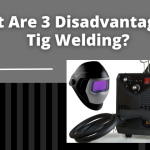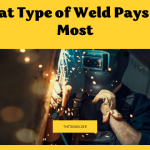Welding is a process that involves joining two or more metal or thermoplastic materials together by melting and fusing them. There are several types of welding techniques, including:
Shielded metal arc welding (SMAW or “stick welding”): This process uses an electric current to create an arc between the welding rod and the workpiece. The heat from the arc melts the rod and the workpiece, creating a weld.
Gas metal arc welding (GMAW or “MIG welding”): This process uses a wire-feeding gun to feed a wire electrode and a shielding gas to protect the weld from contamination. An electric arc melts the wire and the workpiece to create the weld.
Flux-cored arc welding (FCAW): This process is similar to MIG welding but uses a hollow wire electrode filled with flux. The flux helps shield the weld and adds additional filler material.
Tungsten inert gas welding (TIG welding): This process uses a tungsten electrode to create an arc and a shielding gas to protect the weld. To create the bond, the welder must manually feed a filler rod into the weld.
Submerged arc welding (SAW): This process uses a continuously fed electrode and a blanket of granular flux to create the weld. The weld is made beneath the flux, which helps to protect it from contamination.
There are also other specialized welding processes, such as plasma arc welding and laser beam welding, but these are less commonly used.

TIG Welding
TIG welding, also known as gas tungsten arc welding (GTAW), is a process that uses a tungsten electrode to produce an electric arc that heats and melts the metal being welded. A shielding gas, such as argon or helium, protects the weld from contamination.
To begin TIG welding, the welder sets up the welding machine and selects the appropriate tungsten electrode and shielding gas. The tungsten electrode is positioned in a torch, which the welder holds in one hand. The other hand feeds a filler rod into the weld puddle as needed.
To create the weld, the welder first cleans the metal surfaces to be joined and positions them in the proper alignment. The welder then strikes an arc by touching the tungsten electrode to the workpiece and pulling it away slightly. The welder adjusts the current and arc length to control the heat and penetration of the weld.
TIG welding requires high skill and control, as the welder must manually feed the filler rod and maintain the arc while manipulating the torch. It is also important to maintain the proper distance between the electrode and the workpiece, as well as the correct angle of the torch, to produce a high-quality weld.
TIG welding is often used for thin materials, allowing precise control of the weld bead and producing a clean, visually appealing weld. It is also used for welding materials sensitive to contamination, such as aluminum and stainless steel. However, TIG welding can be slower than other welding methods, as it requires more setup and preparation time.
MIG Welding
MIG welding, also known as gas metal arc welding (GMAW), is a process that uses a wire-feeding gun to feed a wire electrode and a shielding gas to protect the weld from contamination. An electric arc melts the wire and the workpiece to create the weld.
To begin MIG welding, the welder sets up the welding machine and selects the appropriate wire electrode and shielding gas. The wire electrode is fed through the wire-feeding gun, which the welder holds in one hand. The other hand guides the gun and controls the welding process.
To create the weld, the welder first cleans the metal surfaces to be joined and positions them in the proper alignment. The welder then strikes an arc by pulling the trigger on the wire-feeding gun and touching the wire to the workpiece. The welder adjusts the current, wire feed speed, and travel speed to control the heat and penetration of the weld.
MIG welding is faster than TIG welding, as the wire-feeding gun continuously feeds the wire electrode into the weld puddle. It is also relatively easy to learn, as the welder does not need to manually feed a filler rod and can focus on maintaining the proper distance between the gun and the workpiece. However, MIG welding can produce spatter and may not be as visually appealing as TIG welding.
MIG welding is commonly used for welding thicker materials, as it can quickly produce strong, high-quality welds. It is also used for welding various materials, including steel, aluminum, and stainless steel.
Stick Welding
Stick welding, also known as shielded metal arc welding (SMAW), is a process that uses an electric current to create an arc between the welding rod and the workpiece. The heat from the arc melts the rod and the workpiece, creating a weld.
To begin stick welding, the welder sets up the welding machine and selects the appropriate welding rod. The rod is held in the welder’s hand and is manually fed into the weld puddle as needed.
To create the weld, the welder first cleans the metal surfaces to be joined and positions them in the proper alignment. The welder then strikes an arc by touching the rod to the workpiece and pulling it away slightly. The welder adjusts the current and arc length to control the heat and penetration of the weld.
Stick welding requires high control and precision, as the welder must manually feed the rod and maintain the arc while manipulating the rod and torch. It is also important to maintain the proper distance between the rod and the workpiece, as well as the correct angle of the torch, to produce a high-quality weld.
Stick welding is a versatile process that can be used on many materials, including steel, stainless steel, and cast iron. It is also relatively easy to set up and can be used in various environments, including outdoor locations where other welding processes may not be practical. However, stick welding can produce slag, which must be removed after completing the weld. It can also produce a rougher, less visually appealing weld than other processes, such as TIG or MIG welding.
Comparison of the Difficulty Level of Different Welding Types
The difficulty level of different welding types can vary based on several factors, including the skill level of the welder, the type of material being welded, and the thickness of the material.
TIG welding is generally considered the most difficult to learn, as it requires a high level of skill and control. The welder must manually feed a filler rod and maintain the arc while manipulating the torch. TIG welding is often used for thin materials and requires precise control of the weld bead to produce a high-quality weld.
MIG welding is generally considered easier to learn than TIG welding, as the wire-feeding gun continuously feeds the wire electrode into the weld puddle. However, MIG welding can still be challenging, as the welder must maintain the proper distance between the gun and the workpiece and adjust the current, wire feed speed, and travel speed to control the weld.
Stick welding is generally considered the easiest to learn, requiring less setup and preparation time than other welding processes. However, stick welding requires high control and precision, as the welder must manually feed the rod and maintain the arc while manipulating the rod and torch. Stick welding is also more prone to producing slag, which must be removed after the weld is complete.
Ultimately, the difficulty level of each welding type will depend on the individual welder and their level of skill and experience. Proper training and practice are essential for mastering any welding technique.
Conclusion
In conclusion, different welding types can vary in their level of difficulty to learn, with TIG welding generally considered the most difficult and stick welding generally considered the easiest. However, all welding types require a certain level of skill and control to produce high-quality welds. Proper training and practice are essential for mastering any welding technique.
It is important to consider the specific needs of a project and choose the appropriate welding process based on the weld’s material, thickness, and desired appearance. TIG welding is often used for thin materials and produces clean, visually appealing welds, while MIG welding is faster and can be used on a wide range of materials. Stick welding is versatile and can be used in various environments but may produce a rougher, less visually appealing weld.
Ultimately, the difficulty level of each welding type will depend on the individual welder and their level of skill and experience. With proper training and practice, any welding type can be mastered.

It’s been years since I got into welding as a side hustle. It’s been so long since Doing All kinds of welds for business and pleasure as this is my hobby. Being in this field I have learned from hands-on-experience also came to know what gears work and what doesn’t. The Tig Welder is my own platform where I use to share my experience.






Leave a Reply